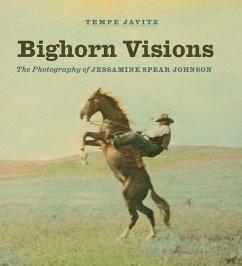"In the late 1800s, eleven-year-old Jessamine Spear Johnson received her first camera from her mother, which would spark her lifelong love of photography. With that camera (and many others), Johnson witnessed and captured the day-to-day activities on her dude ranch and the western frontier in Montana and Wyoming. Her images also depict the rapid changes that took place in the early 1900s, from the increasing prevalence of domestic mammals and modern machinery to the ranch roles held by women to the reservation life of the Crows and Cheyennes. On 25 June 1926, Johnson captured the fiftieth anniversary celebration of the Battle of Little Bighorn. To advance her skill, Johnson also experimented with angles and objects in her compositions and photographic processing techniques that were not common at the time, such as hand-tinting and double-exposure layering, which allowed her to record western scenes in a unique and aesthetically pleasing way. The photographic art of Jessamine Spear Johnson, including iconic prints often not credited to her, is now showcased and explained in this collection"--
Hinweis: Dieser Artikel kann nur an eine deutsche Lieferadresse ausgeliefert werden.
Hinweis: Dieser Artikel kann nur an eine deutsche Lieferadresse ausgeliefert werden.








![The Life of Cardinal Wolsey, and Metrical Visions With Notes by S.W. Singer. [With] Who Wrote Cavendish's Life of Wolsey? by J. Hunter The Life of Cardinal Wolsey, and Metrical Visions With Notes by S.W. Singer. [With] Who Wrote Cavendish's Life of Wolsey? by J. Hunter](https://bilder.buecher.de/produkte/66/66744/66744007m.jpg)